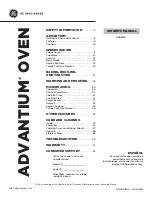
First few times the appliance is lit, it will give off some
odorous fumes. This is caused by the paint curing.
Do not touch the paint work while it is curing otherwise it
can leave a permanent mark on the appliance.
Once the paint has cured it will not re-occur.
Keep the room well ventilated until these fumes have
cleared.
Burn only seasoned hardwood timber with a moisture
content of less than 20%.
Newly cut wood should be allowed to dry/season for 12 to
18 months before use.
Wood should be stored in an environment protected from
the weather to minimise any potential moisture content.
For best results, wood should not exceed 270mm in length
and 150mm diameter. Any larger and appliance will not
operate at its optimum. It is better to burn several smaller
pieces of wood than one large single piece.
Poor quality timber:
-
Causes low combustion efficiency
-
Produces poor emissions (smokey)
-
Results in additional build-up of creosote (soot) in
the flue which will then require regular cleaning
and may result in a flue fire.
Do not burn painted, impregnated/treated wood,
manufactured board products or pallet wood.
1.
Place firelighters and/or paper and dry kindling wood in
the base of the firebox.
2.
Open all air controls :-
a.
by-pass damper – push the lever towards the rear
of the heater
b.
top air slide – pull knob control all the way out (to
the left)
c.
bottom air slide – slide spring handle across to the
left
3.
Light the paper or firelighters.
4.
Once the fire has taken hold add larger pieces of
wood. For optimal burn conditions, place the logs in a
front to back orientation (right angles to the door
opening). Too many logs may smother the fire.
5.
Once the fire is established, close the by-pass damper
by pulling the lever towards the front. This produces a
higher heating efficiency as the heat from the flames is
not lost going directly up the flue.
6.
The bottom air slide should also be closed (slide to the
right). Leaving this open once the fire has established
can risk over-firing and damaging the appliance.
Do not leave fire unattended with bottom air control
open as over-firing may occur.
The heat output of the appliance is controlled by the top air
slide.
High heat output:
After establishing the fire and loading it with larger
pieces of wood, leave it running with the top air slide
fully open.
This setting will generate maximum heat output and
produce high oven temperatures.
Running the appliance with the door open will not
produce maximum heating in the room as it will draw
a lot of already warmed air out of the room.
Similarly running the stove with the top air slide and
the bottom air slide fully open will often not give the
hottest fire as too much heat is lost up the flue and
does not come into the room.
Note that this setting is not the most energy efficient
as some heat is lost up the flue instead of being
transferred into the room.
Do not overload firebox with fuel.
Low heat output:
The heat output of the appliance can be reduced by
closing the top air slide (slide to the right) which will
restrict the oxygen supplied to the fire thereby
slowing down the rate at which the wood burns.
This setting will produce lower oven temperatures.
This setting will provide the best energy efficiency as
the wood burns for longer. However, if not operated
correctly may result in higher particulate emissions.
2. USING APPLIANCE FOR FIRST TIME
3. RECOMMENDED FUELS
4. LIGHTING THE FIRE
5. RUNNING THE APPLIANCE


























